
Why do we manage stormwater?
Under the Clean Water Act (CWA), the federal government began programs to reduce pollution from entering our streams, rivers, and lakes. Stormwater, in the form of rainfall or snowmelt, shares responsibility for carrying pollution to these waterways, so its management has been delegated to local municipalities as part of the MS4 permit program. Some of the pollutants that need to be managed include:
• Sediment or soil
• Road salt
• Fertilizers (specifically nitrogen and phosphorus)
• Herbicides and pesticides
• Excessive heat
• Trash (plastic bottles, food wrappers, cigarette butts, etc.)
While none of these pollutants should enter local streams, rivers, or lakes, each waterway can have its own list of pollutants that are of special interest within that waterway. These lists are known as Total Maximum Daily Loads (TMDLs), or the total amount of identified pollutants that affect a waterway, and are monitored and updated by the Ohio EPA.
How can we limit the pollution that enters the Plum Creek?
There are features known as Stormwater Control Measures (SCMs) or Best Management Practices (BMPs) that can be installed on individual properties and throughout cities to improve stormwater management. Some SCMs can easily be used around residential homes. Other SCMs work better in larger areas.
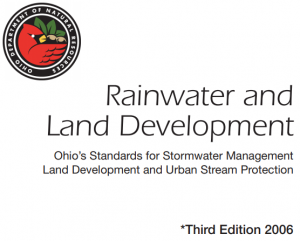 CLICK HERE for technical information on SCMs
CLICK HERE for technical information on SCMs
Rain Gardens
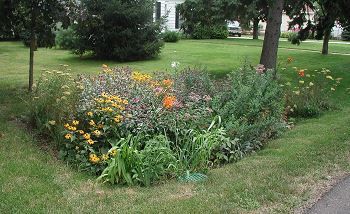
A type of bioretention area designed as a shallow depression in the ground to store runoff from impervious urban areas, like roofs, driveways, walkways, parking lots, and compacted lawn areas. Rain gardens often incorporate native plants.
For more information:
1) Master Rain Gardener Coursepack
2) Lorain County Master Rain Gardener Program
Rain Barrels
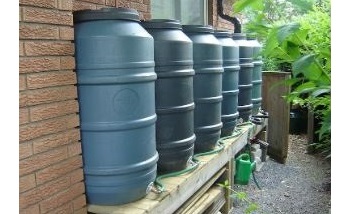
A container used to collect and store stormwater runoff. Typically house or garage gutters are diverted to fill a 55 gallon barrel, which is then used to water lawns or nearby gardens during a dry period. Cisterns are similar to rain barrels, and hold larger quantities of water.
For more information:
1) Rain Barrels Brochure (Lorain County)
2) Rain Barrels Brochure (Cuyahoga County)
Riparian Setback/Buffer Strips
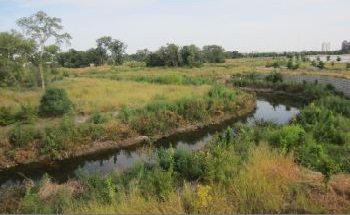
Areas maintained or created along rivers and streams that protect the waterway by reducing the pollution present in water that enters the river or stream from nearby land.
For more information:
1) Riparian Setbacks (CRWP)
2) Riparian Areas and Setbacks
Permeable Pavement
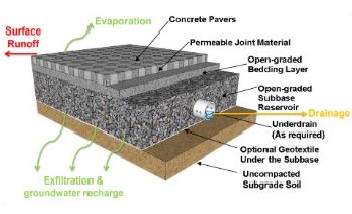
Pervious concrete & asphalt, paving stones and interlocking pavers that allow stormwater to pass through the paving materials to the ground beneath them.
For more information:
1) Permeable Pavement (EPA)
2) Permeable Pavement Fact Sheet
Green Roof

A roof partially or completely covered with vegetation in a growing medium that slows and reduces stromwater from reaching the ground level below.
For more information:
1) Green Roofs (LID Design Guide)
2) Green Roof Design (Bauder)
Vegetated Swales
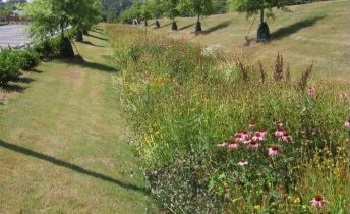
A shallow channel in the ground designed to slow, filter, and infiltrate stormwater. Often, they are densely planted with native grasses, shrubs, and/or trees.
For more information:
1) Vegetated Swale (Pennsylvania)
2) Vegetated Swale (CASQA)
Bioretention Area
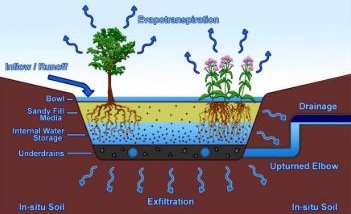
A depressed area designed to store and filter runoff from impervious areas like parking lots and roofs. They can include specific soil media and plants to filter and/or treat stormwater, as well as drain pipes.
For mroe information:
1) Bioretention Guidance (Lake County)
2) Bioretention Gardens (Pennsylvania)
Dry Detention Basin
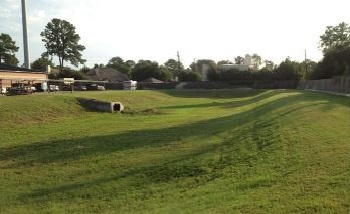
A.k.a. “dry pond” or “detention basin.” Designed to look like a large, grassy low area, it holds water for a short period of time after a storm or melt before draining to a nearby stream.
For more information:
1) Detention Basin
2) Dry Detention Practices (LID Guide)
Wet Detention Basin
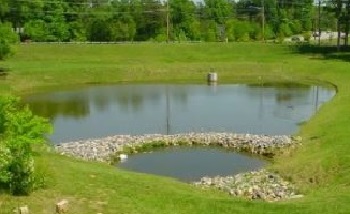
A.k.a. “wet pond” or “retention basin.” Designed as a permanent pool that provides extra storage for a short period of time after a storm or melt before draining to a nearby stream.
For more information:
1) Retention Basins
2) Wet Ponds and Wetlands (EPA)
Underground Detention
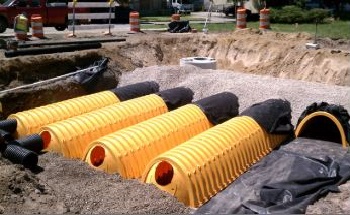
An underground structure or system that stores and slows runoff to nearby streams when there is not surface area to install a pond or basin. These designs do not always remove pollution.
For more information:
1) Dry Wells (New Jersey)
2) Underground Storage (Minnesota)
Oil-Water Separator
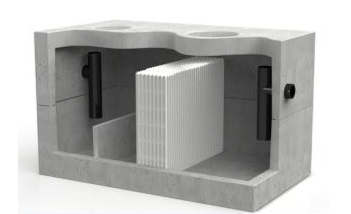
A piece of equipment used to slow water flow, allowing oils to separate from water and be filtered or collected for disposal.
For more information:
1) Oil/Water Separator Info Sheet
2) Oil/Water Separator (API Type)
Resources for care and maintenance of SCMs may be found here:
Northeast Ohio Storm Water Training Council – “Maintaining Stormwater Control Measures: Guidance for Private Owners & Operators”
More information on SCMs may be found here:
Lorain County Storm Water Management – “Implementation Options for More Effective & Efficient Storm Water Control”
Ohio EPA – “Storm Water Technical Assistance” (Rainwater and Land Development Manual can be found here)
US EPA – “What is Green Infrastructure?”
Pennsylvania DEP – “Stormwater Best Management Practices Manual”
Lancaster County Clean Water Consortium – “Homeowner’s Guide: Best Management Practices Operations & Maintenance”
Credit Valley Conservation – “Low Impact Development Stormwater Management Planning and Design Guide”
